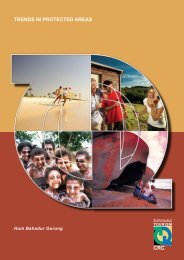icolls - Sustainable Tourism CRC
icolls - Sustainable Tourism CRC
icolls - Sustainable Tourism CRC
You also want an ePaper? Increase the reach of your titles
YUMPU automatically turns print PDFs into web optimized ePapers that Google loves.
ECOLOGY, THREATS AND MANAGEMENT OPTIONS FOR SMALL ESTUARIES AND ICOLLS<br />
northern mouth remained open as ever. The annual mean salinity of the lagoon, prior and after the damming of<br />
the upstream is 27 and 37 psu respectively, thus the normal estuary turned into a perennial hypersaline estuary<br />
after the damming. However, after the closer of the southern mouth, the salinity is below the oceanic during the<br />
Northeast Monsoon, otherwise it remain as a hypersaline estuary with a week horizontal salinity gradient. In the<br />
inner end, the salinity increases far beyond the oceanic, some times to 55 or 60 because of evaporation whereas<br />
the rain periods may lower the salinities to between 20 and 30. Stronger exchange is observed during periods of<br />
slack water and neap tide. The periods of weak or non-existent horizontal gradients are coincided with poor<br />
exchange. The salinity is in constant raise and the water exchange is poor even during the periods of stronger<br />
evaporation, possibly due to the convectional mixing, which may hinder inverse estuarine circulation from being<br />
established. The residence times of the lagoon during the wet and dry seasons are between 40 -100 days but even<br />
longer during the transition between normal to hypersaline estuary. Thus, the frequent shifts from normal to<br />
hypersaline condition bring down the long-term water exchange. Thus, the tropical shallow lagoons being more<br />
sensitive to human impact, the ad hoc regulation of freshwater input into the shallow tropical lagoon may result<br />
in large salinity variation and poor water exchange than in a normal estuary.<br />
Title of paper: The importance of volume correction when investigating plankton dynamics in intermittently<br />
opening and closing lagoons<br />
Author: David Rissik and Iain Suthers<br />
Author's email: dave.rissik@dipnr.nsw.gov.au<br />
Abstract: Increased volume of a closed ICOLL can dilute incoming nutrients, potentially reducing their<br />
influence. Comparing data before and after rainfall events can be difficult because of the associated changes in<br />
volume that may occur. A study in Dee Why lagoon on Sydney’s northern beaches investigated the effects of<br />
volume on plankton responses. To accurately determine volume the bathymetry of the lagoon was determined<br />
and water level data were collected at regular intervals throughout a three-month study during summer, 1999.<br />
Three sampling events were conducted before a rainfall event and six during and after rainfall. Following<br />
rainfall, the volume of the lagoon increased by more than 50%. Plankton data from throughout the study were<br />
transformed to a standard lake volume (the volume on the final sampling event) to enable the real influence of<br />
rainfall to be determined. Accounting for volume made little difference to the trends in plankton responses but<br />
made a difference to the magnitude and hence the significance of the responses. Phytoplankton biomass grew 10<br />
fold within a week after initial rainfall and declined to near initial levels 2 weeks later. Zooplankton responded<br />
within a day with two fold increase in the adult stages of the calanoid copepod Oithona sp., followed a week<br />
later by nauplii and adult Acartia bispinosa. The nutrients from run off, growth and the influx of new<br />
zooplankton into the water column resulted in a depleted 13C and 15N stable isotope signature of A. bispinosa<br />
by 2-4 ppt within 1-2 weeks, consistent with diatom growth and the terrestrial supply of depleted nutrients. D34S<br />
of A. bispinosa was enriched by 2 ppt for 1-2 weeks after rainfall, but unlike C and N, returned to pre-rainfall<br />
levels, indicating the different trophic pathways of C, N and S.<br />
Title of paper: Developing a framework to identify condition, values and management priorities for estuaries in<br />
Australia<br />
Author: Andrew Moss, David Rissik, Dianne Rose<br />
Author's email: andrew.moss@epa.qld.gov.au<br />
Abstract: This paper describes linked projects that are being undertaken by environmental management<br />
agencies in Queensland, New South Wales and Victoria and the Cooperative Research Centre for Coastal Zone,<br />
Estuary and Waterway Management. The aims of all these projects are broadly similar, to set up a framework for<br />
reporting on the condition and values of estuaries and how these interact with each other. Ultimately, the<br />
reporting framework will be used to identify management priorities. The proposed framework will be based on a<br />
Pressure/Condition/Impact (social and economic)/Response model. Indicators for pressure, condition and impact<br />
will be developed through a logical sequence comprising identification of the key pressures â identification of<br />
related pressure indicators â identification of related condition indicators â identification of related social and<br />
economic impact indicators. By following this process we will ensure that there are direct linkages between the<br />
pressures, condition and impact. The project will also seek to quantify these linkages as far as possible. The<br />
qualitative and quantitative links will be important in identifying and prioritising management responses. The<br />
framework will be holistic in that it will seek to cover all aspects of estuary condition including not only<br />
traditional water quality but also biological health, habitat extent and aesthetic condition. The framework will be<br />
designed to allow indicators to be rolled up into composite indices for reporting at a high level while at the same<br />
time it will be possible to report in more detail on individual issues. The project has a number of stakeholders in<br />
Queensland, New South Wales and Victoria. These groups will be used to assess draft frameworks in terms of<br />
their usefulness to local government, community groups and industry.<br />
62











